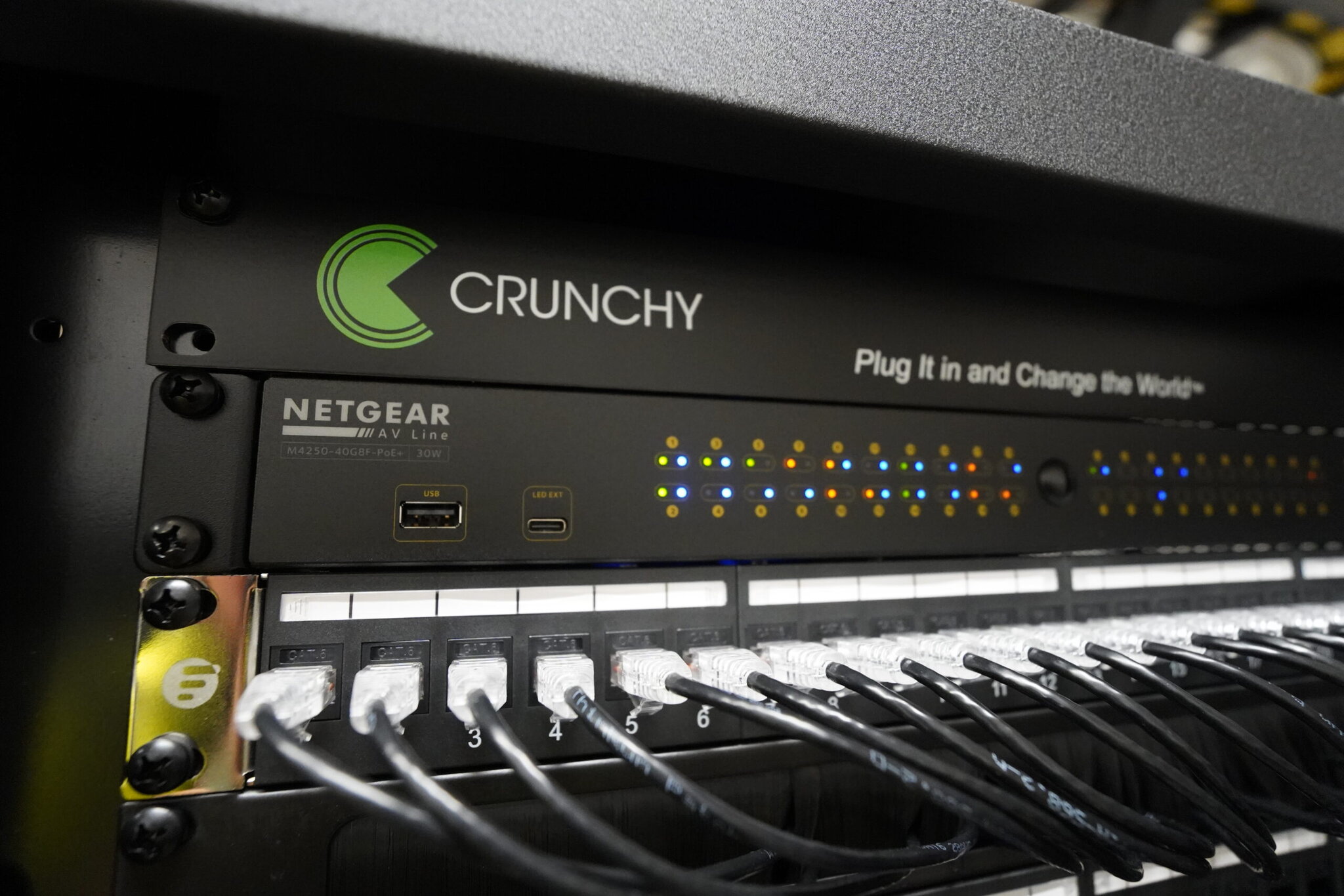If you’re running a hotel, you certainly want your every guest to feel a sense of welcome the minute they set foot into your premises. You also know for a fact that they’re already sizing up the vibe your hotel gives off on day one, forming an opinion to later post online and share with others about their experience.
If you want that feedback to be a five-star review, or if you simply prioritize providing an excellent guest experience regardless of whether they give you stellar ratings for it, then using digital signage is one way to create a positive first impression and keep guest satisfaction high.
Here, let’s talk about digital signage in the hotel industry, their specific use cases, benefits, trends, and statistics you might want to know before investing in commercial AV technology solutions.
What is Digital Signage for Hotels?
Digital signage in hotels is any dynamic display that features helpful content for guests, such as directions, event schedules, weather forecasts, travel information, alerts, and promotions.
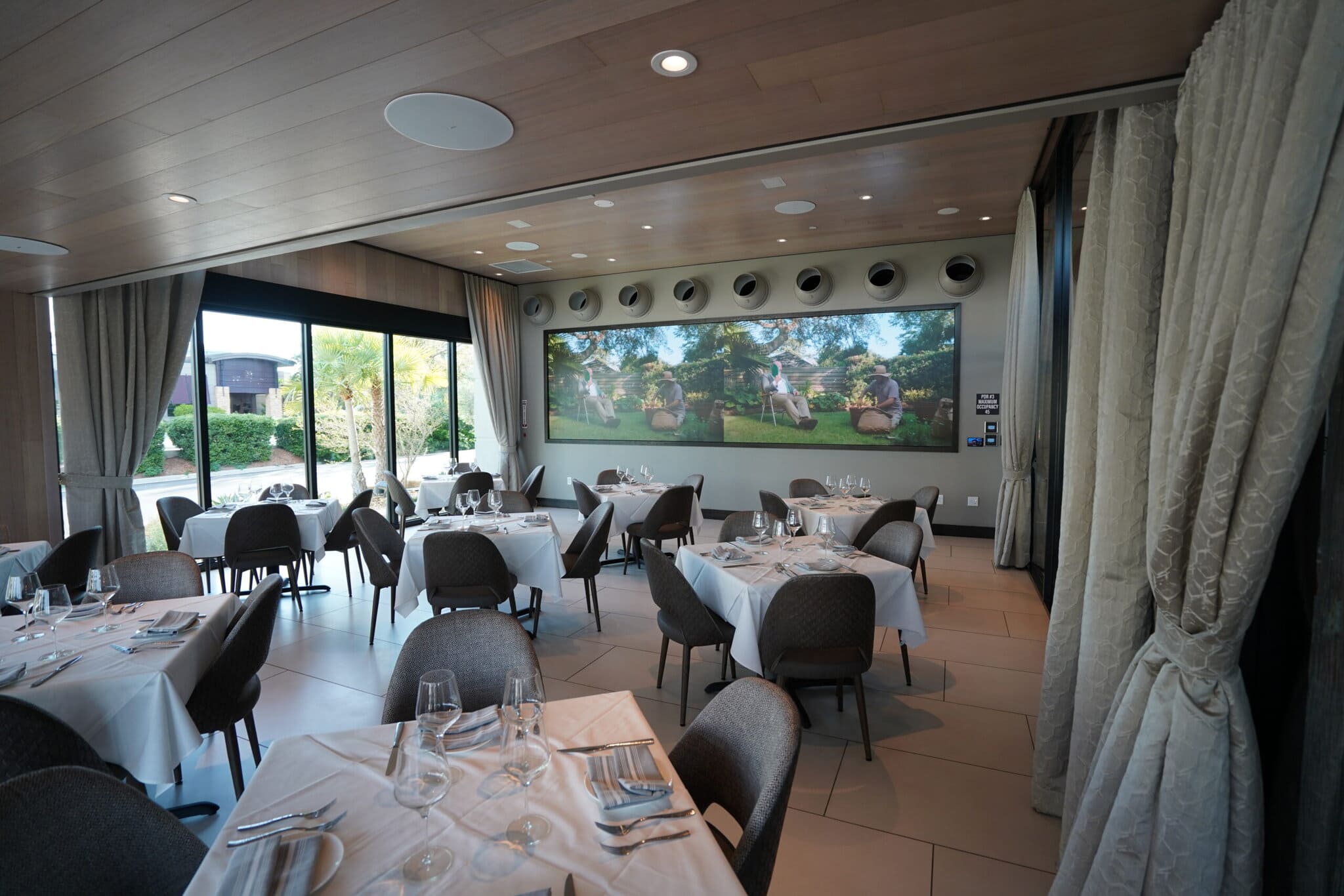
There are various digital signage formats hoteliers commonly use. These include:
- Video Walls: Large-scale displays composed of multiple screens with ultra-thin bezels (for LED types), often used in lobbies or event spaces.
- Interactive Kiosks: Touch-enabled stations or giant iPhones for check-in, concierge services or local information.
- Wayfinding Displays: Digitalized maps and directions to assist guests and/or tourists in navigating the property.
- Room Signage: Outside meeting rooms or event halls, these display schedules and availability.
- Digital Menu Boards: Used in hotel restaurants and bars to show rotating menus and other specials.
- In-Room Displays: Smart screens or tablets offering hotel services, room service ordering or entertainment.
- Digital Billboards: Big outdoor or indoor signs used to fuel branding efforts or third-party advertising.
Each type has its own job to do, but together they create a more connected, efficient and guest-friendly environment.
What are the Benefits of Digital Signage in Hotels?
Here are six big benefits hotels can get from investing in digital signage:
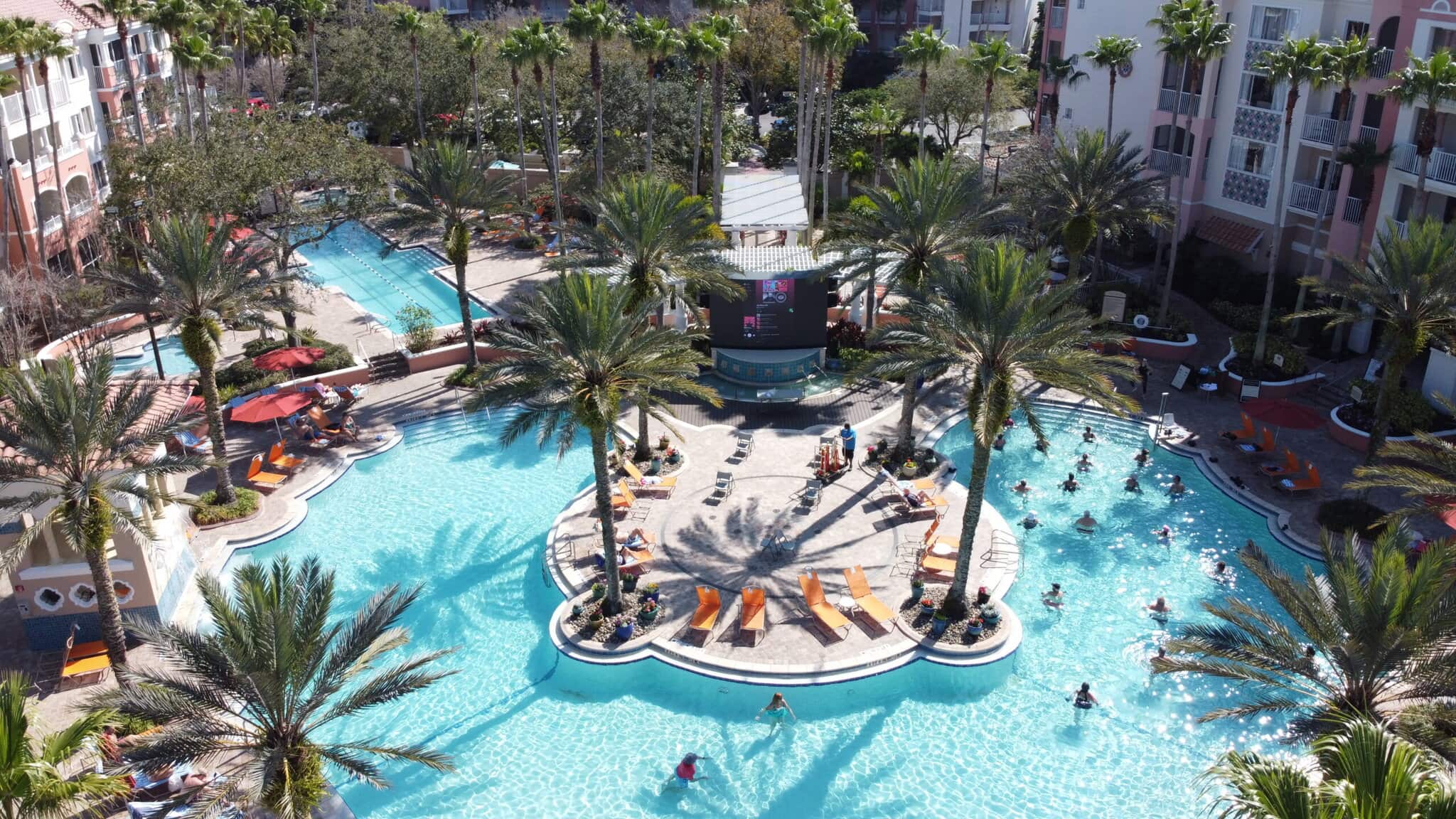
Enhanced Guest Communication
Say a family just checked in after a tediously long flight. Instead of waiting in line to ask where the pool is or what time breakfast starts, they glance at a lobby screen that shows everything clearly (complete with pictures and directions).
It’s self-serve convenience that feels effortless and helps them feel in control and well taken care of throughout their stay.
Improved Brand Perception
Sleek, well-designed signage reinforces your brand’s look and feel, from the colors you use to the tone of your content. So even a quick glance at a screen reminds guests who you are and what you stand for.
It creates a consistent visual experience across your property and communicates that you’re a modern, tech-forward hotel.
Operational Efficiency
Your staff shouldn’t be bombarded with routine questions and explain where the gym is 20x a day. Digital signage takes care of the mundane stuff so they can shift their focus more on high-touch service.
Updating schedules or meeting rooms? Just a few clicks and done. No reprints or confusion.
Revenue Growth
Got a wine tasting tonight, a room upgrade offer, spa services, special dining events? A screen in the elevator or by the front desk can push that message, no sales pitch necessary.
It’s low-effort marketing that works around the clock. You can also generate ad revenue by promoting local businesses and attractions.
Eco-Friendly Practices
If eco-consciousness is part of your company ethos, going digital means reducing paper waste and energy use tied to traditional print materials, e.g., brochures and posters. Many modern screens are energy-efficient and built with sustainability in mind.
Cost Savings
Think about all the signs hotels print… menus, flyers, room directories, event notices. Now imagine never having to reprint any of it. With digital signage, everything is editable from a dashboard.
That saves on materials, time, and hassle. Sure, there’s an upfront investment, but it makes it needless to constantly reprint brochures, flyers, etc.
Where Hotel Digital Signage Displays are Conveniently Used
Hotel digital signage solutions are not limited to one area or aspect of your daily business operations. It can be used all over the place. Here are a few ways you can put it to work:
Hotel lobbies
It’s the first thing guests see, might as well make it memorable! Use digital signage to show live weather, flight updates or highlight hotel amenities. A slick lobby screen sets the tone for your guests’ stay.
Conference and meeting rooms
Keep event-goers in the loop with real-time meeting room updates, branding and agenda displays. If you’re attending a big business conference, there’s nothing more helpful than knowing exactly where to go and when without having to find someone to ask.
Hallways and elevators
These high-traffic spots are perfect for bite-sized digital signage content. Promote happy hour, show directions or tease upcoming events. It’s passive engagement that works.
You’re waiting for the elevator anyway, so why not catch a glimpse of tonight’s dinner special or tomorrow’s yoga class?
Hotel restaurants and bars
You walk into the bar and see a mouthwatering video of a sizzling steak or signature drink. Boom, decision made! Ditch static menus for rotating specials, photos of featured dishes or spotlighting the mixologist’s cocktail of the month. It’s dynamic, appetizing and easy to update.
Guest rooms
Say farewell to flipping through outdated brochures. Everything’s right there on screen, a tap away. Digital displays in the room give guests instant access to information, be it to order room service, browse the hotel directory or check out local attractions. It’s convenience at their fingertips.
Pool and spa areas
Keep guests informed about spa appointment times, pool hours or towel service locations. Maybe you’re relaxing by the pool and notice a digital sign advertising a sunset massage promo. That’s the kind of upsell that doesn’t feel like a pitch.
Fitness centers
Post workout class times, trainer bios or even play motivational videos. Guests on fitness routines will appreciate seeing a clear schedule without needing to ask.
Behind the Screens: AV Infrastructure That Makes It Work
Behind every eye-catching screen is a well-oiled system operating quietly in the background. There’s a whole AV infrastructure ensuring hotel managers that the screen does what it’s intended for 24/7 without hiccups.
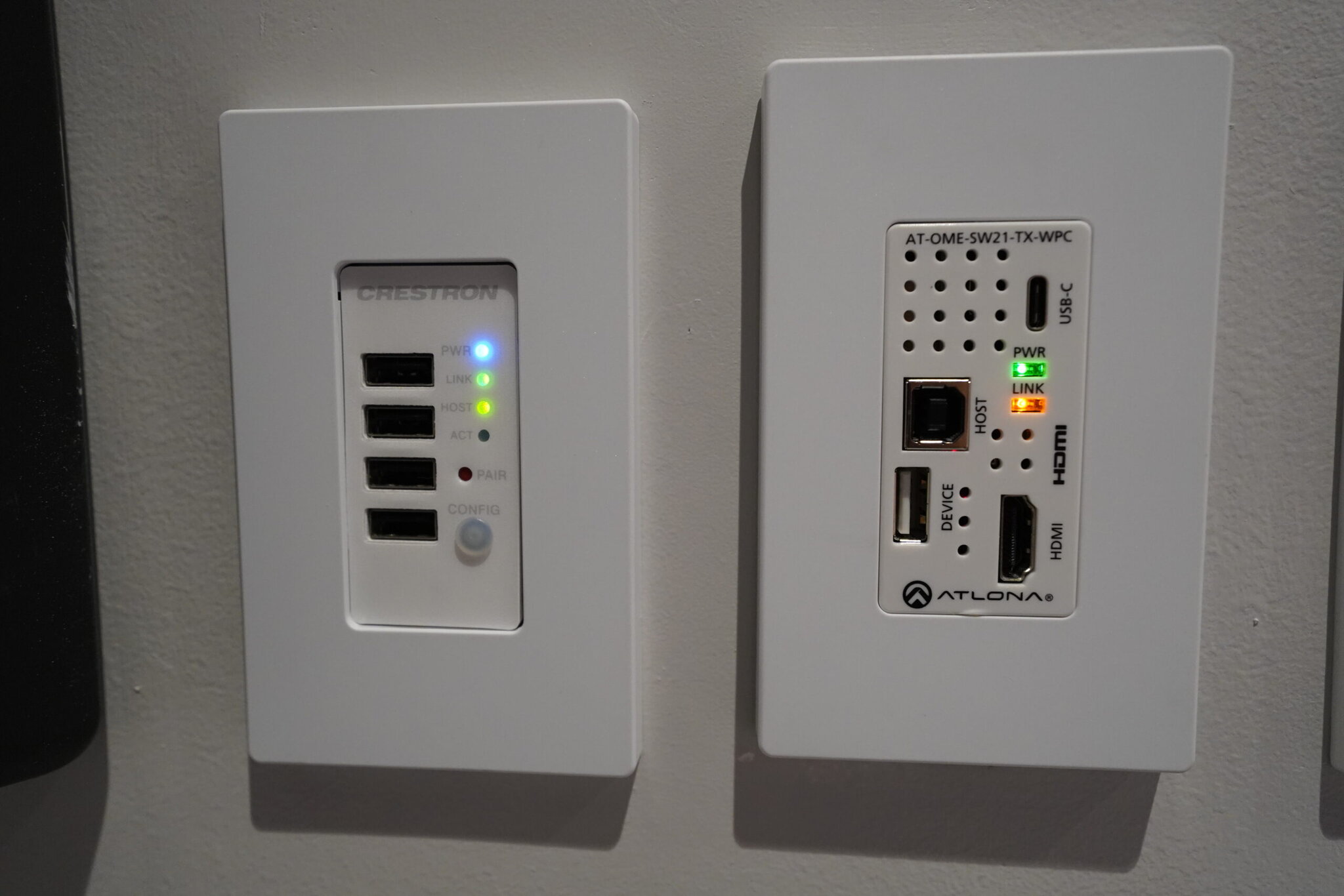
Commercial-grade screens
These aren’t your typical TV displays. They’re built for constant use, with higher brightness to cut through daylight glare in lobbies and more rugged hardware to survive wear and tear.
A standard TV might last a couple of years in this kind of environment, whereas a commercial-grade screen is designed for the long haul.
Reliable network connections
Every display needs to stay connected to the hotel’s network so it can receive real-time updates. Think: new promotions, event info, or welcome messages.
Whether it’s via wired Ethernet or a secure Wi-Fi setup, this connection is what allows dynamic content to flow seamlessly across screens throughout the property.
CMS (Content Management System)
This is the brain of the operation. A hotel manager or marketing team can log into a dashboard and control what’s playing on every screen, from the lobby welcome board to the restaurant menu to the in-room directory.
You can schedule content by time of day, set it for certain locations only or even create campaigns around holidays or local events.
Integration with existing hotel systems
When your signage talks to your Property Management System (PMS), you can automatically pull in guest names for personalized welcomes.
Tie it to your CRM, and suddenly you’re showing loyalty-based offers or recognizing frequent guests with exclusive messages. It turns signage into a connected part of the guest journey.
This whole system needs to be designed thoughtfully. Because the more moving parts you have the more potential points of failure. That’s why working with the right AV partner matters.
At Crunchy Tech, we map out your space, tailor the digital signage system to your property’s goals, and make sure everything—and we mean everything—from the CMS to the cabling—is ready to scale as your needs grow.
The flashy screens get the attention. But it’s the tech behind them that makes the magic work wonders.
Statistics of Digital Signage in Hospitality
If you’re still on the fence about going digital, these numbers speak for themselves:
- A study found that 7 out of 10 hotel guests say digital displays make their stay more enjoyable.
- Hotels using digital signage are also seeing results on the books. Some properties report up to a 20% bump in revenue from on-screen promotions, with 65% of guests saying those displays make the hotel feel more modern and useful.
- When it comes to food service, research shows digital menu boards can lead to a 38% boost in impulse buys, thanks to clean layouts and visual cues that make ordering easier (and faster).
- And if you’re wondering whether digital signage is just a trend: the global market is on track to hit $29 billion in 2025, and it’s projected to nearly double by 2034. In short: screens are here to stay, and they’re only getting smarter.
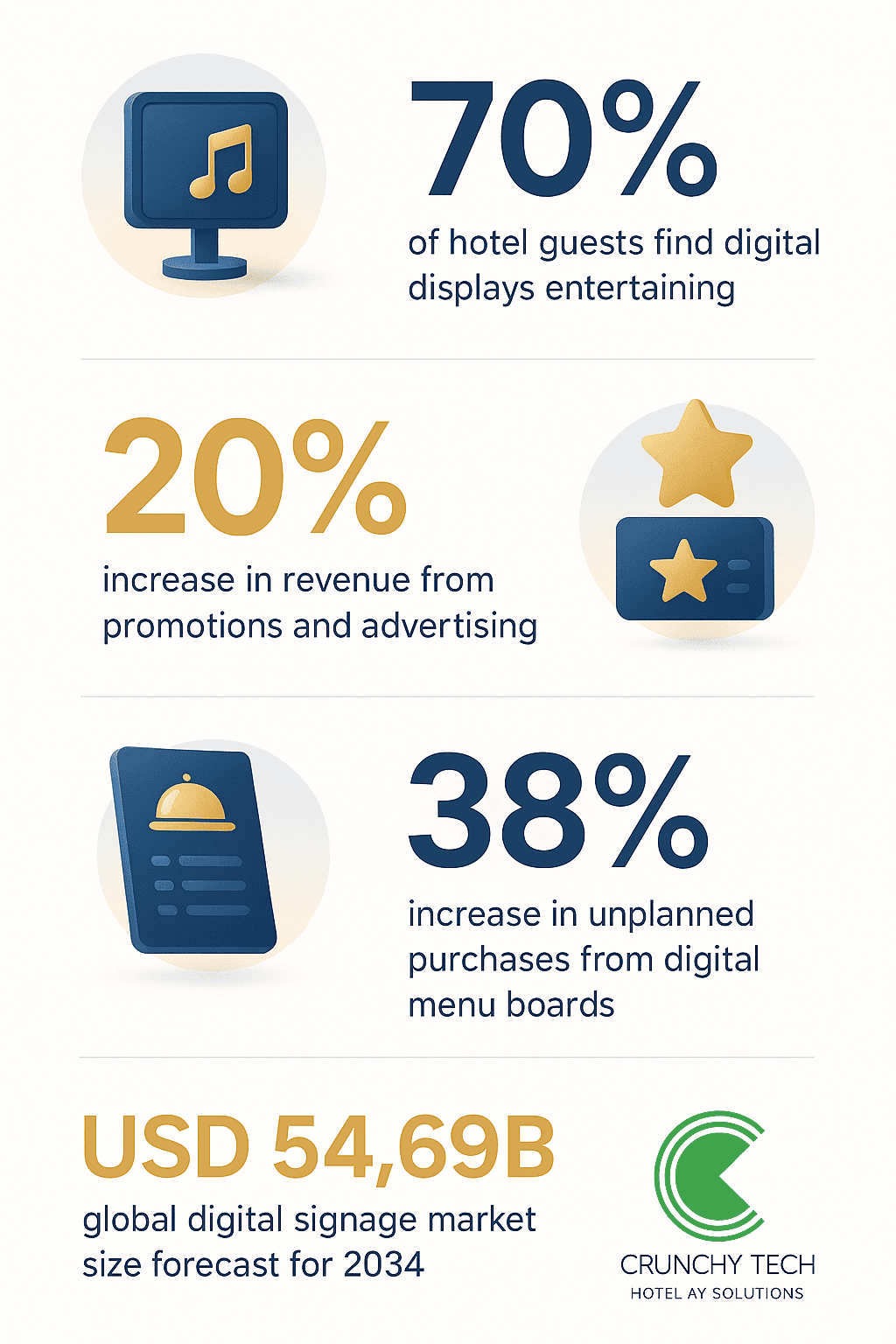
Top Hospitality Digital Signage Trends
It’s worth looking at trends in order to adapt to the ever-changing landscape of the hospitality industry. Here’s what’s trending right now and how it can give your hotel an edge if implemented:
1. Personalization Powered by Data and AI
With digital signage that integrates with your CRM or PMS, you can greet loyalty members by name, show language-specific content for international travelers or suggest amenities based on their past stays.
AI tools can even automate some of this, such as adjusting the content based on time of day, guest demographics or check-in patterns.
2. Mobile Interactivity and QR Code Integration
People and their phones are inseparable in today’s age. Signages that bridge the gap between screen and mobile device are winning. We’re seeing a lot more QR code use, where guests can scan to view menus, book services or get turn-by-turn directions on their phone.
Think of a guest scanning a hallway screen to add a spa appointment to their schedule without even talking to the front desk. It’s digital convenience right in their hands.
3. Sustainable, Low-Energy Displays
More hotels are going green, and digital signage can actually support those efforts. New LED and OLED displays are super energy-efficient, and cloud-based digital signage content management cuts out the need for printed materials.
Besides saving paper, you’re reducing electricity usage too. Some signage even has motion sensors to dim or power off when no one’s nearby. Smart and eco-friendly.
4. Touchless & Voice-Activated Displays
Post-pandemic, hygiene awareness is here to stay. That’s why touchless technology is on the rise: displays that respond to gestures, proximity sensors or even voice commands.
Picture a kiosk in the lobby where a guest waves their hand to bring up local attractions or says “room service” to browse the in-room dining menu. Less contact, more comfort.
5. Real-Time Content & Live Feeds
Static content is out, real-time content is in. Hotels are using digital signage to show live weather, local event schedules, flight status boards and even social media feeds. It keeps the screens dynamic and useful.
A guest grabbing coffee in the lobby can spot a live update about a pop-up event in the hotel bar later that night. That’s how signage drives action.
6. Branded Storytelling & Experiential Content
This one’s big for boutique hotels and resorts that lean into storytelling. Instead of just showing utility info, digital signage can become a canvas for brand expression.
Think curated videos about the local culture, stories behind your hotel’s design, or behind-the-scenes looks at the chef prepping a signature dish. Done well, it deepens guest connection and turns casual visitors into brand advocates.
7. Seamless Integration Across Properties
For hotel groups and chains, centralized control of signage across multiple locations is a huge trend. Content can be customized locally, but managed from one dashboard.
That’s ideal for pushing corporate messages, promoting chain-wide offers, or maintaining a consistent look and feel across cities or regions. It’s having one voice across all your properties without losing local flavor.
Choosing the Right Hotel Digital Signage Solution
Choosing the right solution means finding one that fits your hotel not just technically, but also operationally and aesthetically. So where do you start?
Look for hospitality-specific experience
A company that knows retail or education AV might not understand the flow of a hotel lobby or the needs of a guest checking in at midnight. Hospitality has its own rhythm.
You want a partner who knows how digital signage needs to adapt to everything from weddings to business conferences. And who understands how to blend tech into your guest experience without disrupting it.
Integration is a game-changer
Make sure the system can plug into what you already use. If your hotel runs on a Property Management System like Opera or Maestro, or you rely on Salesforce for customer data, your digital signage should connect with that.
That way, it becomes a dynamic, personalized communication tool.
Scalability matters
Maybe you’re starting with one lobby screen, but in a year you want to expand to all rooms, restaurants and even outdoor signage. You shouldn’t have to rip and replace to grow.
A good digital signage solution will scale with you, adding new screens and locations without reinventing the wheel every time.
Ease of use
You don’t want to call IT department every time you need to change a dinner special. Your front desk staff, your event coordinator or even your marketing intern should be able to log in and make quick updates.
Look for an intuitive content management system that doesn’t require an information technology background to operate.
Ongoing support and service
Things happen. A screen might go blank or a network hiccup might mess with a content feed. The right AV partner won’t leave you hanging.
Look for someone who offers responsive support, remote troubleshooting, and a clear maintenance plan. It’s akin to having a digital concierge for your signage system.
Content strategy included
Lastly, a great signage provider won’t just talk hardware. They’ll help you think through what to put on the screens.
- What should be shown in the lobby vs. the elevator?
- How often should content rotate?
- How do you align messages with the guest journey?
A good partner will walk you through that, not just hand you a screen and wish you luck.
At the end of the day, your signage solution should be a strategic extension of your brand, your service model and your vision for guest experience.
Digital Signage in the Hotel Industry FAQs
What is digital signage in a hotel for?
Digital signage in a hotel is there to make the guest experience smoother, more engaging, and a whole lot more efficient. Think of it as your hotel’s personal assistant showing guests where to go, what’s happening and what they might want to try next (like that happy hour at the bar).
It replaces static signs with dynamic screens that can display real-time updates, personalized messages or interactive content. It comprises keeping guests informed and impressed without needing to stop by the front desk every time.
What is the purpose of digital signage display in a hotel?
The purpose is pretty straightforward: communication. But it’s more than just telling people where the gym is. Digital signage helps hotels deliver timely, relevant content whether it’s wayfinding, event schedules or promotions.
It’s also a subtle branding tool. Every screen is a chance to reinforce your hotel’s personality, make guests feel welcome and upsell services without being pushy.
What is an example of a hotel digital signage?
A good example? Picture a sleek screen by the elevators showing the daily events, a welcome message with the guest’s name, and maybe a promo for tonight’s live music in the lounge.
Or an interactive touchscreen kiosk in the lobby where guests can explore nearby attractions, check-in digitally or book a massage. These are service tools that save time, enhance experience and drive revenue.
What to look for in a digital signage software for hotels?
Look for ease and flexibility. Your signage software should let you update content quickly (without calling IT every single time), schedule things in advance and connect with your existing systems like your PMS or CRM.
Bonus points if it supports multiple languages, interactive content and mobile integration. Most importantly, it should be reliable and backed by support. Because the last thing you need is a frozen welcome screen on a fully booked weekend.
Boost Hotel Guest Experience With Crunchy Tech
At the end of the day, hotel guests want two things: to feel taken care of and to have a smooth, enjoyable stay. Digital signage hotel solutions make that easier. We’re talking about better guest experiences, stronger brand presence and yes, even more revenue.
More than an AV vendor, Crunchy Tech is a partner who gets your world. If you’re ready to work with a team that understands the unique rhythm of hotels, let’s have a conversation.
